
|
Astronomy Picture Of the Day (APOD)
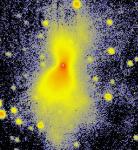 Cold Wind From The Boomerang Nebula
Cold Wind From The Boomerang Nebula
15.10.1997
A cold wind blows from the central star of the Boomerang Nebula. Seen here in a false color image of dust reflected starlight, the nebula lies about 5,000 light-years away. The boomerang shaped...
 Venus On The Horizon
Venus On The Horizon
14.10.1997
The month of October features a sky full of planets, including Venus as the brilliant evening star. Besides the sun and moon, Venus is the brightest object visible in Earth's sky. This month, Venus appears in early evening near the red planet Mars and Mars' red giant rival Antares above the southwestern horizon.
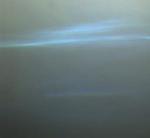 Ice Clouds over Mars
Ice Clouds over Mars
13.10.1997
Mars has clouds too. The above true color image taken in August by Mars Pathfinder shows clouds of ice high in the Martian atmosphere. Unlike Earth's atmosphere which is composed predominantly of nitrogen and oxygen, Mars' atmosphere is composed mostly of carbon dioxide.
 Impact! 65 Million Years Ago
Impact! 65 Million Years Ago
12.10.1997
What killed the dinosaurs? Their sudden disappearance 65 million years ago, along with about 70 percent of all species then living on Earth, is known as the K-T event (Cretaceous-Tertiary Mass Extinction event). Geologists and paleontologists often entertain the idea of a large asteroid
 Floating Free in Space
Floating Free in Space
11.10.1997
NASA astronauts can float free in space without any connection to a spaceship. Here astronaut Bruce McCandless maneuvers outside the Space Shuttle Challenger by firing nitrogen gas thrusters on his manned maneuvering unit (MMU). This picture was taken in 1984 and records this first untethered spacewalk. The MMU was developed because astronauts found tethers restrictive.
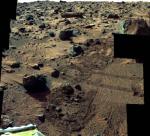 Mars Pathfinder Super Pan
Mars Pathfinder Super Pan
10.10.1997
Spectacular details of rover tracks, wind-driven soil, and textured rocks on the Martian surface fill this color mosaic. The view is north-northeast from the Sagan Memorial Station at the Pathfinder landing site on Mars.
 Hale Bopp and the North American Nebula
Hale Bopp and the North American Nebula
9.10.1997
Comet Hale-Bopp's recent encounter with the inner Solar System allowed many breath-taking pictures. Above, Comet Hale-Bopp was photographed on March 8th in the constellation of Cygnus. Visible on the right in red is the North American Nebula, a bright emission nebula observable from a dark location with binoculars.
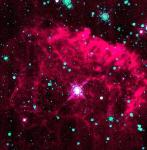 The Brightest Star Yet Known
The Brightest Star Yet Known
8.10.1997
Star light, star bright, a new brightest star has been discovered in the night. This new brightest star is so far away and so obscured by dust, however, that it took the Hubble Space Telescope to confirm it.
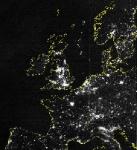 Europe at Night
Europe at Night
7.10.1997
This is what Europe looks like at night! Can you find your favorite European city? Although not all of Europe is shown, city lights might make this task possible. Continental outlines have been artificially drawn in yellow. The above picture is actually a composite of over 200 images made by satellites orbiting the Earth.
 Surveyor At Mars
Surveyor At Mars
6.10.1997
Mars Global Surveyor achieved Martian orbit on September 11 and began aerobraking into its final mapping orbit, a process that will take until March next year. Anticipating the labors ahead, Mars Orbital Camera operators have begun acquiring test images.
|
January February March April May June July August September October November December |
|||||||||||||||||||||||||||||||||||||||||||||||||